Unlocking Inner Peace Through Mindful Movement
Mindful movement transcends the typical workout; it’s a holistic practice that intertwines physical activity with mental awareness, cultivating inner peace and well-being. Unlike exercise solely focused on physical fitness goals, mindful movement emphasizes the present moment, connecting body and mind in a harmonious dance. This connection fosters self-awareness, reduces stress, and cultivates a deeper sense of tranquility. Various practices fall under the mindful movement umbrella, each offering unique benefits and approaches.
Yoga: A Foundation of Mindful Movement
Yoga, with its ancient roots, stands as a cornerstone of mindful movement. Different styles, from the gentle restorative flows to the vigorous power yoga, all share a core principle: the union of breath and movement. Asanas, or postures, are held with intention, requiring focus on the body’s sensations and the breath’s rhythm. This mindful attention shifts focus inward, reducing mental chatter and promoting relaxation. The deep stretches and controlled breathing stimulate the parasympathetic nervous system, counteracting the effects of stress hormones like cortisol. Furthermore, yoga’s emphasis on breathwork (pranayama) enhances self-regulation, enabling individuals to better manage emotions and stress responses. Studies have shown yoga’s efficacy in reducing anxiety, depression, and chronic pain. The meditative aspects inherent in holding poses and focusing on breath cultivate a sense of calm and inner peace, facilitating emotional regulation and self-acceptance.
Tai Chi and Qigong: Cultivating Internal Harmony
Tai Chi Chuan and Qigong, ancient Chinese practices, elegantly blend slow, flowing movements with deep breathing and meditation. These gentle yet powerful practices promote balance, flexibility, and inner harmony. The emphasis on smooth, deliberate movements fosters a heightened body awareness, allowing practitioners to connect with their physical sensations and energy flow (Qi). The slow, rhythmic movements, coupled with focused breathing, promote relaxation and reduce muscle tension. This, in turn, reduces stress and anxiety levels. Practitioners often report an enhanced sense of calm and well-being following a session. Tai Chi and Qigong are particularly beneficial for older adults, improving balance and reducing the risk of falls, while also offering mental and emotional benefits. Research suggests that these practices can improve cardiovascular health, reduce blood pressure, and enhance cognitive function.
Walking Meditation: Finding Stillness in Motion
Walking meditation, a deceptively simple practice, requires conscious attention to the physical sensations of walking. It involves paying close attention to the feeling of each footfall, the movement of the legs, and the rhythm of the breath. Unlike a brisk walk, walking meditation emphasizes slow, deliberate steps, fostering a mindful connection with the present moment. This heightened awareness helps to quiet the mind, reducing racing thoughts and fostering a sense of peace. The repetitive nature of walking can become meditative, allowing the mind to settle and find a state of tranquility. This practice can be done virtually anywhere, making it an accessible tool for cultivating inner peace throughout the day. It’s particularly beneficial for those who find it challenging to sit still for prolonged periods during meditation.
Dance: Embodied Expression and Joyful Movement
Dance, in its various forms, offers a powerful avenue for mindful movement. Whether it’s ballet, contemporary, or freestyle, the act of moving the body to music naturally engages the mind and body. The focus on expressing emotions and sensations through movement facilitates self-expression and emotional release. Dance can be a cathartic experience, allowing individuals to process emotions and reduce stress through physical expression. The rhythmic nature of dance, coupled with the focus on physical sensations, encourages a state of flow, promoting a sense of joy and well-being. The mindful aspects of dance become pronounced when the focus shifts from performance to the experience of the movement itself, appreciating the feeling of the body in motion and the rhythm of the breath.
Pilates: Precision, Strength, and Mindfulness
Pilates, known for its focus on core strength and body awareness, incorporates elements of mindful movement. The precision and control required in each exercise necessitate a heightened awareness of the body’s alignment and movement patterns. This focus on the present moment fosters a mindful connection between body and mind. The controlled breathing techniques used in Pilates further enhance this connection, promoting relaxation and reducing stress. Practitioners often report an improved sense of body awareness and a greater connection to their physical sensations. The emphasis on precision and control cultivates a sense of discipline and self-mastery, contributing to a feeling of inner peace and stability.
Mindful Movement Beyond Specific Practices:
The principles of mindful movement can be applied to almost any physical activity. Gardening, cleaning, or even walking the dog can become mindful practices when approached with attention to the present moment. Focusing on the sensations of the activity, engaging all senses, and paying attention to the breath can transform everyday tasks into opportunities for cultivating inner peace. The key is to approach these activities with intention, shifting focus away from distractions and toward the present experience. This cultivates a deeper appreciation for the simple things and enhances the overall sense of well-being. The benefits of mindful movement extend beyond the physical; it cultivates a greater sense of self-awareness, reduces stress, and fosters a deeper connection with oneself and the world around. Consistent practice is key to reaping its transformative benefits.





